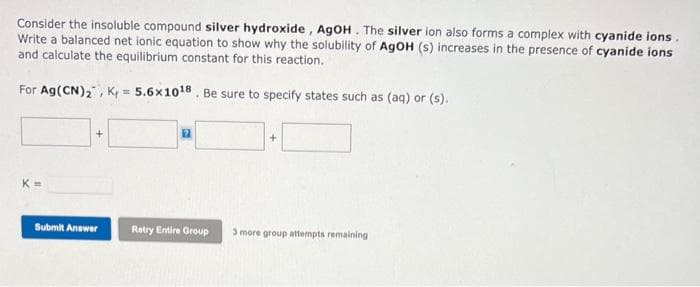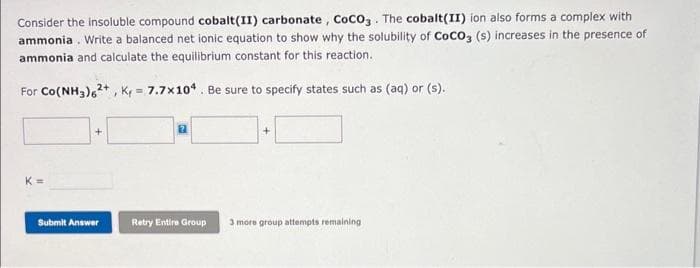Consider the insoluble compound silver hydroxide, AgOH. The silver ion also forms a complex with cyanide ions. Write a balanced net ionic equation to show why the solubility of AgOH (s) increases in the presence of cyanide ions and calculate the equilibrium constant for this reaction. For Ag(CN)₂, K= 5.6x1018. Be sure to specify states such as (aq) or (s). K= + 12
Consider the insoluble compound silver hydroxide, AgOH. The silver ion also forms a complex with cyanide ions. Write a balanced net ionic equation to show why the solubility of AgOH (s) increases in the presence of cyanide ions and calculate the equilibrium constant for this reaction. For Ag(CN)₂, K= 5.6x1018. Be sure to specify states such as (aq) or (s). K= + 12
Chemistry & Chemical Reactivity
10th Edition
ISBN:9781337399074
Author:John C. Kotz, Paul M. Treichel, John Townsend, David Treichel
Publisher:John C. Kotz, Paul M. Treichel, John Townsend, David Treichel
Chapter22: The Chemistry Of The Transistion Elements
Section: Chapter Questions
Problem 82GQ: The transition metals form a class of compounds called metal carbonyls, an example of which is the...
Related questions
Question

Transcribed Image Text:Consider the insoluble compound silver hydroxide, AgOH. The silver ion also forms a complex with cyanide ions.
Write a balanced net ionic equation to show why the solubility of AgOH (s) increases in the presence of cyanide ions
and calculate the equilibrium constant for this reaction.
For Ag (CN)₂, K= 5.6x10¹8. Be sure to specify states such as (aq) or (s).
K=
+
Submit Answer
17
Retry Entire Group
+
3 more group attempts remaining

Transcribed Image Text:Consider the insoluble compound cobalt(II) carbonate, CoCO3. The cobalt(II) ion also forms a complex with
ammonia. Write a balanced net ionic equation to show why the solubility of CoCO3 (s) increases in the presence of
ammonia and calculate the equilibrium constant for this reaction.
For Co(NH3)2+, K = 7.7x104. Be sure to specify states such as (aq) or (s).
K=
Submit Answer
Retry Entire Group
3 more group attempts remaining
Expert Solution
This question has been solved!
Explore an expertly crafted, step-by-step solution for a thorough understanding of key concepts.
This is a popular solution!
Trending now
This is a popular solution!
Step by step
Solved in 3 steps

Knowledge Booster
Learn more about
Need a deep-dive on the concept behind this application? Look no further. Learn more about this topic, chemistry and related others by exploring similar questions and additional content below.Recommended textbooks for you

Chemistry & Chemical Reactivity
Chemistry
ISBN:
9781337399074
Author:
John C. Kotz, Paul M. Treichel, John Townsend, David Treichel
Publisher:
Cengage Learning

Chemistry & Chemical Reactivity
Chemistry
ISBN:
9781133949640
Author:
John C. Kotz, Paul M. Treichel, John Townsend, David Treichel
Publisher:
Cengage Learning

Chemistry: Principles and Reactions
Chemistry
ISBN:
9781305079373
Author:
William L. Masterton, Cecile N. Hurley
Publisher:
Cengage Learning

Chemistry & Chemical Reactivity
Chemistry
ISBN:
9781337399074
Author:
John C. Kotz, Paul M. Treichel, John Townsend, David Treichel
Publisher:
Cengage Learning

Chemistry & Chemical Reactivity
Chemistry
ISBN:
9781133949640
Author:
John C. Kotz, Paul M. Treichel, John Townsend, David Treichel
Publisher:
Cengage Learning

Chemistry: Principles and Reactions
Chemistry
ISBN:
9781305079373
Author:
William L. Masterton, Cecile N. Hurley
Publisher:
Cengage Learning

Chemistry: An Atoms First Approach
Chemistry
ISBN:
9781305079243
Author:
Steven S. Zumdahl, Susan A. Zumdahl
Publisher:
Cengage Learning


Chemistry
Chemistry
ISBN:
9781305957404
Author:
Steven S. Zumdahl, Susan A. Zumdahl, Donald J. DeCoste
Publisher:
Cengage Learning